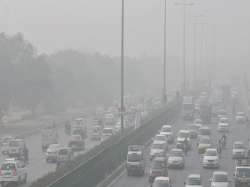Delhi pollution level shoots up after brief respite; rains predicted on Nov 14-15 likely to clear smog
Pollution level skyrocketed by the hour in Delhi on Sunday, turning the air quality hazardous, which agencies consider unfit for inhalation even by healthier people.

Pollution level skyrocketed by the hour in Delhi on Sunday, turning the air quality hazardous, which agencies consider unfit for inhalation even by healthier people.
The hourly graph of the Central Control Room for Air Quality Management, which had briefly fallen below emergency levels yesterday, recorded PM2.5 and PM10 concentration at 478 and 713 micrograms per cubic metre by afternoon.
Meanwhile, Delhi government has said that all schools in national capital shall reopen on Monday.
However, all government and private schools in Gurugram will remain close on Monday in view of the alarming air pollution levels.
Also, in Ghaziabad, classes of all private and government schools up to 12th standard will open at 9am from Monday onwards.
The corresponding 24-hour safe standards are 60 and 100. Visibility came down below 100 metres at many places.
The air quality index of the CPCB had a score of 460, as against yesterday's 403. The most dominant pollutants were PM 2.5 and CO, according to the CPCB air bulletin.
People complained of burning sensation in their eyes and heaviness in breathing, reflecting the severity of the pollution.
The PM2.5 reading of the Centre-run SAFAR (System of Air Quality and Weather Forecasting and Research) was also above 400, which is in the severe category as well.
If the prevailing levels of PM2.5 and PM10 persist for another 24 hours, the odd-even scheme is supposed to be implemented, according to the Graded Response Action Plan (GRAP) being enforced by the Environment Pollution (Prevention and Control) Authority.
The NGT had yesterday said that the odd-even scheme should be implemented "without any default" as and when PM (particulate matter) 10 level goes above 500 microgrammes per cubic metre and PM 2.5 level crosses the limit of 300 microgrammes per cubic metre during a span of 48 hours.
CPCB and SAFAR scientists maintained that the fresh spike in pollution was triggered mainly due to drop in inversion layer (the layer beyond which pollutants cannot disperse into the upper layer of the atmosphere), which in turn happened due to sharp drop in minimum and maximum temperatures.
The CPCB's air lab chief Dipankar Saha said the haze was basically a mixture of dust and moisture. Formation of a thick cloud cover also resulted in the spike in moisture and drop in both minimum and maximum temperatures, he said.
All hopes on rains predicted on Nov 14-15
Light rains predicted on November 14 and 15 is likely to clear the smog in Delhi and bring respite to the people gasping for breath.
The minimum temperature today touched 13 degrees Celsius, one notch below the season's average while the maximum temperature was recorded at 28.4 degrees Celsius.
Humidity levels oscillated between 98 per cent and 51 per cent.
According to the MeT department, moderate fog will prevail Delhi tomorrow morning and mostly clear sky during the day.
Light rains have been predicted in the national capital on November 14 and 15, which, the MeT officials say, could clear the smog, giving some relief to Delhiites.
The national capital has been experiencing dense smog for the past a few days, forcing authorities to enforce emergency measures such as banning construction activities and brick kilns due to worsening air pollution.
The "odd-even" rationing of cars, which was scheduled to begin on Monday, was however deferred by the Delhi government after the National Green Tribunal ordered the withdrawal of exemptions given to women and two-wheelers under the scheme.
(With PTI inputs)
